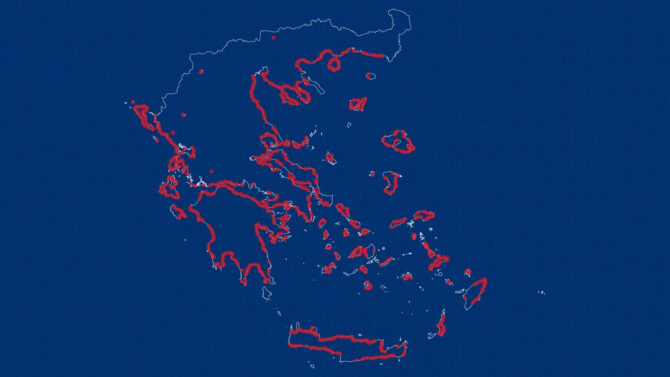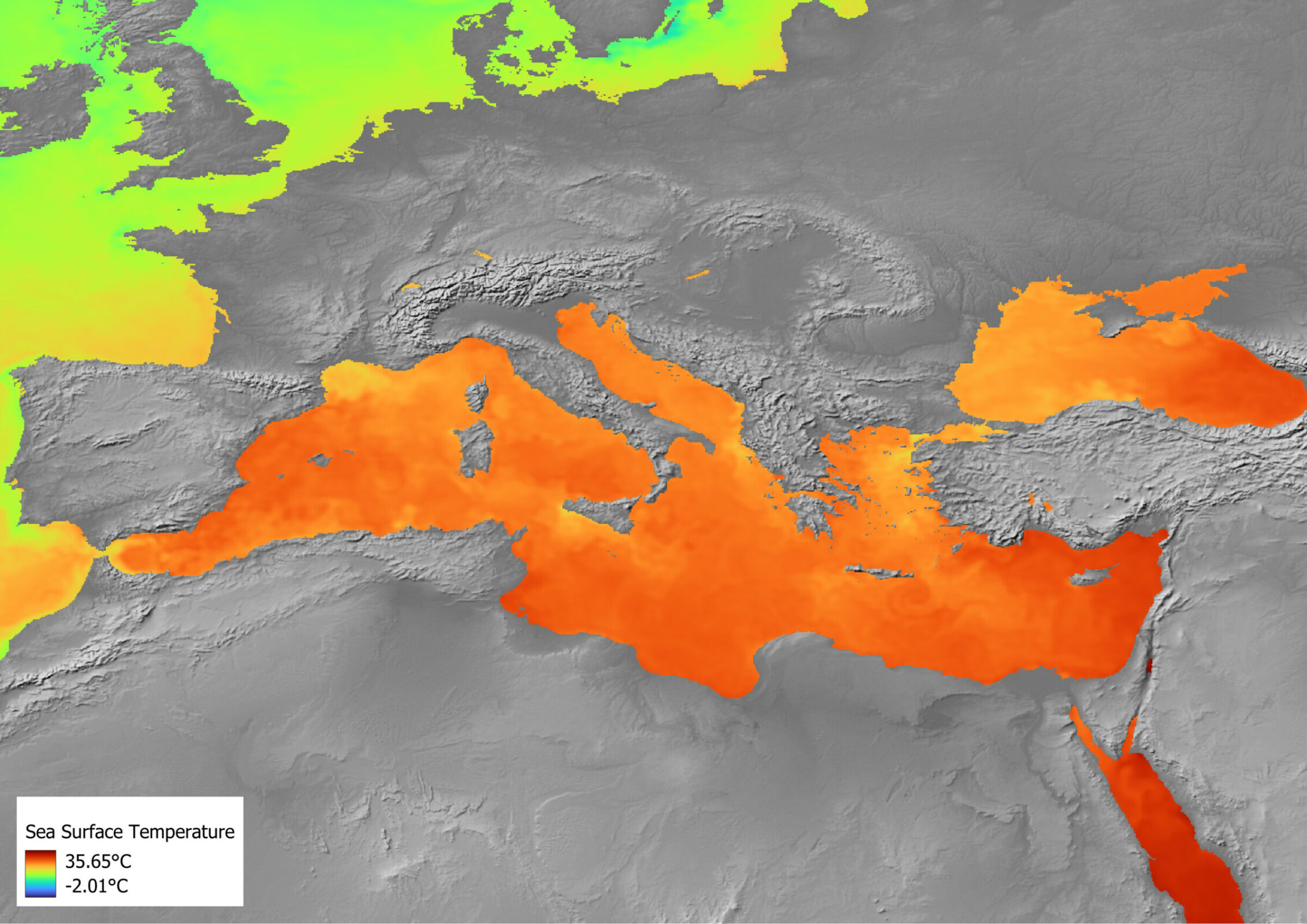In August, the Mediterranean experienced its largest sea temperature increase on record, posing a threat to marine life and potentially triggering extreme weather events similar to those caused by storm Daniel.
MyCoast app: A data analysis of leasing agreements for beaches in Greece

A statistical analysis of 9,170 beach and coastal concessions as presented in the MyCoast application.
The parrotfish, found in the waters of the Mediterranean and the eastern Atlantic, is a species that prefers warm waters. “In the past, you had to go to the Southern Cyclades or Crete to see parrotfish,” recounts Dr. Charilaos Kontogiannis, a physicist, oceanographer, and researcher at the Institute of Oceanography of the Hellenic Centre for Marine Research, who started snorkeling as a child. “Now, 40 years later, you can find them as far north as the Saronic Gulf and even further northward. Warming oceans are enabling the spread of thermophilic species to more northern latitudes”.
The average temperature in the Mediterranean set a record on 16 August 2024, reaching 28.5°C for the first time. On the same day, the temperature in the parts of the Aegean Sea reached 28°C and 29.5°C in the Ionian Sea, according to Copernicus Marine Service data.
In fact, this record in the Mediterranean has been broken repeatedly since March 2023. This supports the Intergovernmental Panel on Climate Change‘s (IPCC) 2019 report stating, “Since 1993, the rate of ocean warming has more than doubled. Marine heatwaves have very likely doubled in frequency since 1982 and are increasing in intensity.” The Mediterranean, Baltic, and Black Seas are warming faster than the global average. Additionally, in a study by Dr. Kontogiannis, which analysed the average temperatures of the Black Sea and the Aegean Sea up until 2000, it was observed that since 1995, there has been a marked increase in sea temperatures—and they continue to rise.


What is causing the rise in temperature?
Humans have significantly accelerated climate change and global warming. When the atmosphere is impacted, the oceans are also affected.”Fortunately and unfortunately, the climate is influenced by more than just two factors, and one of these factors is human presence,” says Dr. Michalis Petrakis, Former Director of the Institute of Environmental Research at the Athens Observatory.
“The upper layer of all oceans is in direct contact with the atmosphere,” explains Dr. Kontogiannis. “So, the temperature of the sea is largely determined by the temperature of the atmosphere.” As stated in the IPCC report, “It is almost certain that the global ocean has warmed unabated since 1970 and has absorbed more than 90% of the excess heat in the climate system.” This means that, until now, climate change has been mitigated by the ocean’s absorption of heat, as it covers 70% of the planet’s surface and is resistant to change. However, as the atmosphere continues to warm, the ocean’s temperature will also rise.
Another factor contributing to the rise in ocean temperatures in 2023 was the El Niño phenomenon, which brings warmer-than-usual conditions to the Pacific. El Niño made a significant impact first in 2015-2016, followed by its counterpart, La Niña, which causes cooler-than-usual Pacific conditions. While El Niño is not uncommon, the Pacific’s temperature in 2023 showed “a remarkable jump” compared to the values observed over the past two decades.
Sea surface temperature difference between 2024 and 2023

Higher Levels, More Salt
The effects of ocean temperature changes extend far beyond the migration of parrotfish. Yannis Stamatakis, a meteorologist and founder of forecastweather.gr, emphasizes that severe storms like Daniel are closely linked to the rising temperatures in the Mediterranean. He warns that similar phenomena could occur again. Stamatakis explains that weather patterns are primarily influenced by sea temperatures. Warmer seas lead to increased lightning activity, heavier rainfall, more intense snowfall and snowstorms, and the formation of hydro-cyclones.
David Faranda, director of the Extreme Climate Events Group at the Climameter Laboratory for Climate and Environmental Sciences in Paris, explains in an article in Kathimerini, “In the Mediterranean, we are seeing an abnormal warming. The warm sea then transfers heat and moisture into the atmosphere, so when bad weather arrives in the Mediterranean basin, it finds enough moisture and heat to create a strong storm”. “Cyclones draw their energy from the tropics, where they interact with warm waters. This process has recently begun to occur in the Eastern Mediterranean,” adds Kontogiannis. While Mediterranean cyclones may not match the intensity of those in the Atlantic, they share similar characteristics and are equally unpredictable.
Sea surface temperature difference between 2024 and 2023 in the Mediterranean

At the same time, higher temperatures affect salinity, or the salt content of the oceans. “Now that people are talking about water scarcity—lack of fresh water, reduced rainfall—the salt content increases. That’s because there is no rain. Evaporation, precipitation, rainfall, and snowfall are the phenomena that determine salinity. In other words, the sea loses a lot of water, which increases both its salinity and its temperature,” explains Kontogiannis.
Melting ice and the subsequent rising sea levels are significant concerns for scientists. Dr. Petrakis explains that millions of years ago, intense volcanic activity shaped the Mediterranean region, forming many of its beaches. “If the ice melts due to warming, the resulting water from places like Greenland, Iceland, and Antarctica will cause sea levels to rise, which can have dramatic effects on coastal areas.” Kontogiannis adds that as sea levels rise, the increased wave action can further erode these areas.
Ultimately, the most immediate impact is on biodiversity. Biodiversity refers to the variety of species that constitute an ecosystem. “Biodiversity represents a balance on the planet. This balance is disrupted if temperatures rise […] We won’t see biodiversity destroyed overnight, but the gradual destruction is already underway.” Rising ocean temperatures contribute to increased ocean acidity, reduced oxygen levels, and the loss of marine ecosystems. As these ecosystems decline, species are forced to move, creating new “hosts.” The parrotfish is just one species that has now established itself in the warming Mediterranean.